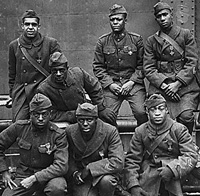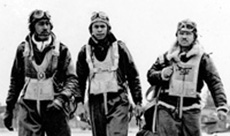Segregation permeated Army behavior in the early days of World War II. Many segregated black units were assigned to posts and bases in the southern United States for training, where commanders applied "local laws and customs," which often meant strict segregation. The practice of segregation even spread to northern facilities and overseas, so that posts and bases in these areas were segregated even when the local communities were not. A military report in 1943 noted that
the Army, by its directives and by actions of commanding officers, has introduced Jim-Crow practices in areas, both home and abroad, where they have not heretofore been practiced.1

Nurses in England, 1944
Source: Library of Congress, Toni Frissell Collection
LC-USC4-6175/LC-USZ62-119985
Black Americans engaged in a variey of tactics to demonstrate their dissatisfaction with official military segregation. While some resorted to violence and others wrote letters, a number of black Americans acted with discipline, organization, and a commitment to non-violent methods against unequal treatment by the military; against segregated military transportation; and against segregated facilities like post and base exchanges, movie theaters, and officers' clubs. This was a true grassroots movement, involving small groups, using a number of methods at a number of different locations, and without centralized leadership.

Soldiers in WWI
Source: National Archives
The War Department might have known that race relations in the military were going to be a problem when the United States entered World War II. About 200,000 black Americans had served in France during World War I, some in combat units, and black Americans had protested their treatment by the military before and during that war. Perhaps the only surprise is how long it took the military to come to terms with the problems that occurred during WWII. As the size of America's military grew throughout the War, the number of black Americans in uniform would increase, and so would the protests against the military's formal and informal segregation policies.

Student Fighter Pilots at Tuskegee
Source: US Air Force



